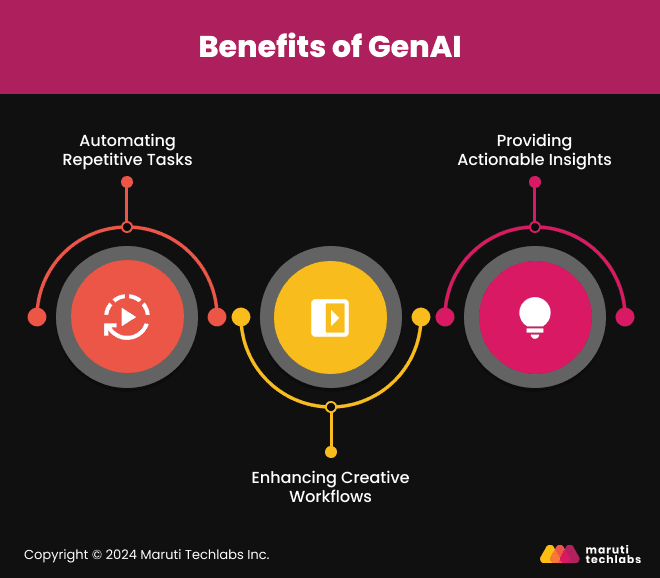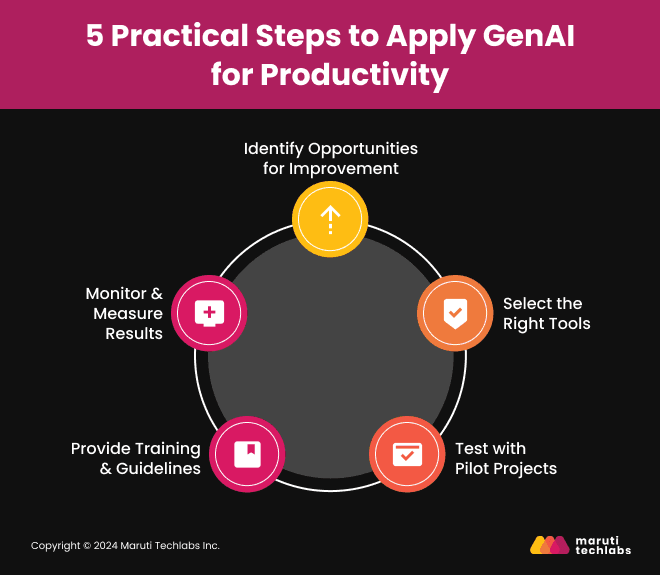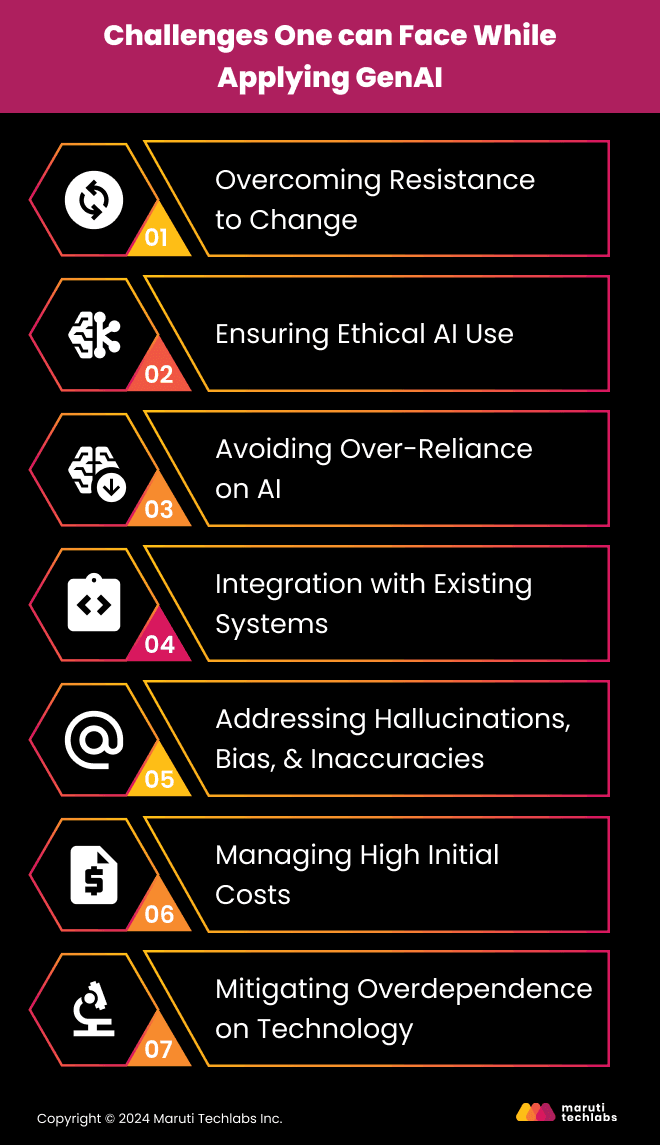

How to Effectively Apply GenAI to Increase Team Productivity?






Imagine a tool that not only assists your team but actively boosts creativity, solves problems, and automates tedious tasks—welcome to the world of Generative AI (GenAI). This approach changes the way teams work and makes them more efficient and innovative by helping them focus on important tasks that make an impact.
So, what makes GenAI so impactful? It’s not just an automation tool; it is a catalyst for creativity and strategic problem-solving. In this blog, we’ll explore the practical strategies for applying GenAI to enhance team productivity. Let’s dive into how to make it work for you.
GenAI is a very big advancement in artificial intelligence. It is designed to create content, analyze data, and provide intelligent solutions. Unlike the other traditional AI models such as Linear Regression, Hidden Markov Models (HMMs), Support Vector Machines (SVMs), etc., which only focus on following rules or analyzing past patterns, GenAI, on the other hand, can generate new ideas, enabling dynamic problem-solving and creative applications.
GenAI helps simplify work by taking care of repetitive tasks, saving time, and making things more efficient. It also provides useful insights to support smarter decisions.

When you bring GenAI into your workflows, it opens up new possibilities and enhances performance in many areas, including:
Beyond these individual advantages, GenAI has the power to redefine team dynamics and amplify productivity.
Generative AI can transform team productivity by addressing inefficiencies and enhancing collaboration in previously unimaginable ways. Its impact is evident across key areas of team workflows:
Real-world examples demonstrate these benefits in action:
Harnessing these benefits requires a thoughtful approach to integrating GenAI into workflows.
Introducing GenAI into your team's workflow needs some careful planning. To make the transition easier and get the best results, start by identifying areas to improve, choose the right tools, begin with small projects, provide training, and measure success along the way.

Assess your current workflows. Identify processes that are repetitive, time-consuming, or prone to errors. These could range from content creation and data analysis to customer support tasks. By focusing on these areas, you can determine where GenAI can deliver the most value.
Not all GenAI tools are created equal, so choosing those that align with your team’s needs is crucial. For example, creative teams might benefit from Jasper for content generation, while Otter.ai could improve meeting efficiency. Evaluate each tool’s scalability, ease of use, and ability to integrate with your existing systems.
Begin by implementing GenAI solutions on a small scale, such as within a single team or for a specific project. This allows you to monitor the tool’s effectiveness and gather feedback before rolling it out organization-wide.
Equip your team with the skills needed to work effectively alongside AI tools. Conduct workshops, share tutorials, and establish clear usage guidelines to ensure ethical and secure implementation. Address any concerns about AI adoption to foster confidence and acceptance.
Define measurable outcomes, such as improved task completion times, enhanced quality, or higher employee satisfaction. Review performance metrics regularly to ensure the tools meet your productivity goals and identify areas for improvement.
A well-executed strategy ensures these tools deliver sustained productivity gains across your organization.
GenAI tools have become essential for enhancing productivity across various team functions. With their ability to streamline tasks, foster creativity, and improve efficiency, these tools transform how teams work. Here’s an overview of some standout options across key areas:
AI-powered writing tools streamline content production. Platforms like Jasper and Copy.ai generate compelling copy for blogs, social media, and advertisements, saving hours of manual effort. Grammarly remains an industry favorite for refining tone and grammar, while Canvas AI features to make designing professional visuals intuitive and quick.
AI tools shine in data-driven decision-making. Tableau AI enables teams to visualize and interpret complex datasets effectively, while Microsoft Copilot and ChatGPT simplify generating reports and summaries, ensuring faster and more accurate insights.
AI-based solutions make it easier to keep teams connected. Otter.ai automatically transcribes meetings and provides concise summaries, making discussions more actionable. Descript enhances video and audio editing for collaborative projects, and Slack’s AI features improve workflow management and team communication.
For developers, tools like GitHub Copilot and Tabnine offer intelligent code suggestions, accelerating development cycles. These tools reduce coding time and help minimize errors by recommending best practices.
While these tools enhance productivity, integrating GenAI also introduces challenges that teams must navigate.
Implementing GenAI presents several challenges that organizations must navigate to adapt successfully.

Here are the top hurdles teams may face:
AI adoption often meets with skepticism or fear of job displacement. Organizations should prioritize clear communication and offer training programs to demonstrate how AI complements human skills. Building a culture of trust and promoting AI as a tool for empowerment, not replacement, is essential for smoother integration.
When incorporating AI into workflows, maintaining ethical standards is crucial. Organizations must ensure data privacy, adhere to strict AI governance policies, and regularly audit AI systems to prevent misuse. Transparency in AI decisions helps mitigate unintended consequences.
While GenAI is a powerful tool, it shouldn’t replace human judgment, especially in critical decision-making. Organizations must balance AI outputs with human oversight to ensure accuracy and accountability in high-stakes situations.
GenAI tools must seamlessly integrate into existing digital infrastructures. Compatibility issues may disrupt workflows, so a clear strategy for integration and technical support is necessary to ensure smooth transitions without productivity loss.
AI models can generate misleading or biased outputs, particularly if trained on flawed data. AI systems must be monitored, continuously trained, and refined through algorithm improvements to maintain credibility and reliability.
Adopting AI productivity tools often involves significant upfront investment in capital and training. This barrier can discourage smaller organizations or startups from integrating AI tools effectively. Identifying high-impact use cases early and gradually scaling AI adoption can help maximize ROI while managing costs.
Heavy reliance on AI systems can lead to disruptions if technical issues, such as system downtime or errors, arise. Organizations need robust contingency plans and should continue encouraging human creativity and decision-making to reduce dependence on automated solutions.
To make the most of GenAI, begin with small, simple projects that fit your team’s needs. Pick the right tools for the right jobs and encourage new ideas. Take it step by step, adding AI to improve workflows. Start by automating one task and see the benefits firsthand.
Contact Maruti Techlabs for tailored solutions and guidance on applying GenAI to your team’s workflows. Start your journey toward greater efficiency today.
Not sure where to begin? Use our AI Readiness Calculator to assess your team's preparedness and uncover the best starting point.
GenAI, or Generative AI, is an advanced form of artificial intelligence that can create content, analyze data, and generate innovative ideas. Unlike traditional AI models that follow pre-defined rules, GenAI uses complex algorithms to produce new and creative outputs, making it ideal for tasks like content creation, data analysis, and brainstorming.
Some recommended GenAI tools include:
Choosing the right tools depends on your team’s specific needs and workflows.
Not necessarily. Start by identifying those tasks which can be automated or enhanced with AI. Select tools compatible with your current systems and run pilot projects. Finally, training must be provided to ensure smooth adoption and technical support should be sought if needed.
The main challenges include:
Contact professional service providers like Maruti Techlabs for tailored solutions and expert guidance. They can help you identify the right tools and strategies for effectively integrating GenAI into your workflows.


